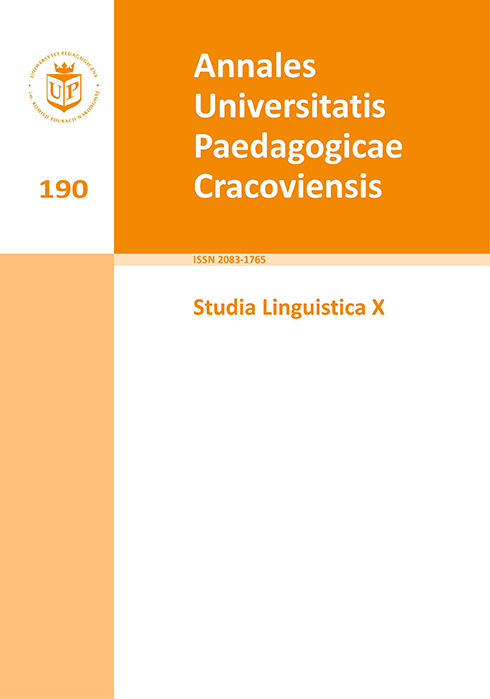Obraz wysokogórskiej przyrody w sonetach tatrzańskich Wincentego Byrskiego
Main Article Content
Abstract
This analysis is based on an unpublished collection of 25 sonnets written by Wincenty Byrski one hundred years ago. They are devoted to the Tatra subject matter. The author of the article, applying the methods of cultural linguistics, discusses the descriptions of the mountain nature in the poetic language of W. Byrski. The research is focused on the toponyms, the lexis referring to different rock formations, watercourses, animated nature, atmospheric phenomena and the elements. Simultaneously, the author comments on the solemnly marked lexis, archaisms, regional expressions and comparative structures used by the poet.
Downloads
Article Details
Author, submitting a text to the editorial board of the journal “Annales Universitatis Paedagogicae Cracoviensis. Studia Linguistica", certifies that the content of the article has not been published so far and that the work does not violate in any way the copyright or related rights of other person, as well as other rights of third parties, and that no one's rights to the work (or any part thereof) have been missed. After signing the contract, the property rights to the published materials are transferred to the Scientific Publisher of the University of the National Education Commission, Krakow.
“Annales Universitatis Paedagogicae Cracoviensis. Studia Linguistica” is an open access journal, and all its content is made available free of charge to users and institutions under the Creative Commons CC-BY-NC-ND 4.0 license (attribution, non-commercial use, no derivative works). Under this license, the authors agree that their work may be lawfully reused for any purpose, except for commercial purposes, without the prior consent of the author or publisher. Everyone can read, download, copy, print, distribute and process these works, provided that the author's marking and the original publication place are correct. Published texts may not be used to create derivative works (e.g. to translate and publish in another language without the consent of the publisher). This is in line with the BOAI (Budapest Open Access Initiative) definition. "Studia Linguistica" does not charge for submitting or processing articles.
References
Budziszewska W., 1965, Słowiańskie słownictwo dotyczące przyrody żywej, Wrocław.
Google Scholar
Grzegorczykowa R., 1999, Pojęcie językowego obrazu świata, [w:] Językowy obraz świata, red. J. Bartmiński, Lublin, s. 39–46.
Google Scholar
Hałat B., 2010, Wincenty Byrski – zapomniany poeta, „Zeszyty Społeczno-Historyczne Gminy Kozy”, nr 4: Ludzie – krajobrazy, red. A. Nowak, s. 27–48.
Google Scholar
Olma M., 2014a, Matka i ojciec w języku poetyckim Wincentego Byrskiego z Kóz, „Małopolska. Regiony – Regionalizmy – Małe Ojczyzny”, t. XVI, red. Z. Noga, s. 137–150.
Google Scholar
Olma M., 2014b, Obraz podbeskidzkiej wsi przełomu XIX i XX stulecia w twórczości poetyckiej Wincentego Byrskiego, [w:] Język w środowisku wiejskim, t. II: Gwara – społeczeństwo – kultura, red. E. Rudnicka-Fira, M. Błasiak-Tytuła, Kraków, s. 257–271.
Google Scholar
Piotrowicz A., Witaszek-Samborska M., 2011, Świat przyrody w gwarze miejskiej Poznania, [w:] Ścieżkami pięknej polszczyzny, red. L. Mariak, A. Seniów, Szczecin, s. 185–199.
Google Scholar
Rejter A., 2003, Świat przyrody w prozie Olgi Tokarczuk. Stereotyp – reinterpretacja – kreacja, „Język Artystyczny”, t. 12: Literatura kobiet, literatura kobieca, kobiecość w literaturze, red. B. Witosz, Katowice, s. 115–139.
Google Scholar
Sicińska K., 2011, Funkcje nazw geograficznych w cyklu „Na Skalnym Podhalu” Kazimierza Tetmajera, „Rozprawy Komisji Językowej Łódzkiego Towarzystwa Naukowego”, t. LVI, s. 139–161.
Google Scholar
Spólnik A., 1990, Nazwy polskich roślin do XVIII wieku, Wrocław.
Google Scholar
Turska H., 1959, Język opisów przyrody w „Panu Tadeuszu” wobec tradycji polskiego klasycyzmu, [w:] O języku Adama Mickiewicza, red. Z. Klemensiewicz, Wrocław, s. 185–330.
Google Scholar
